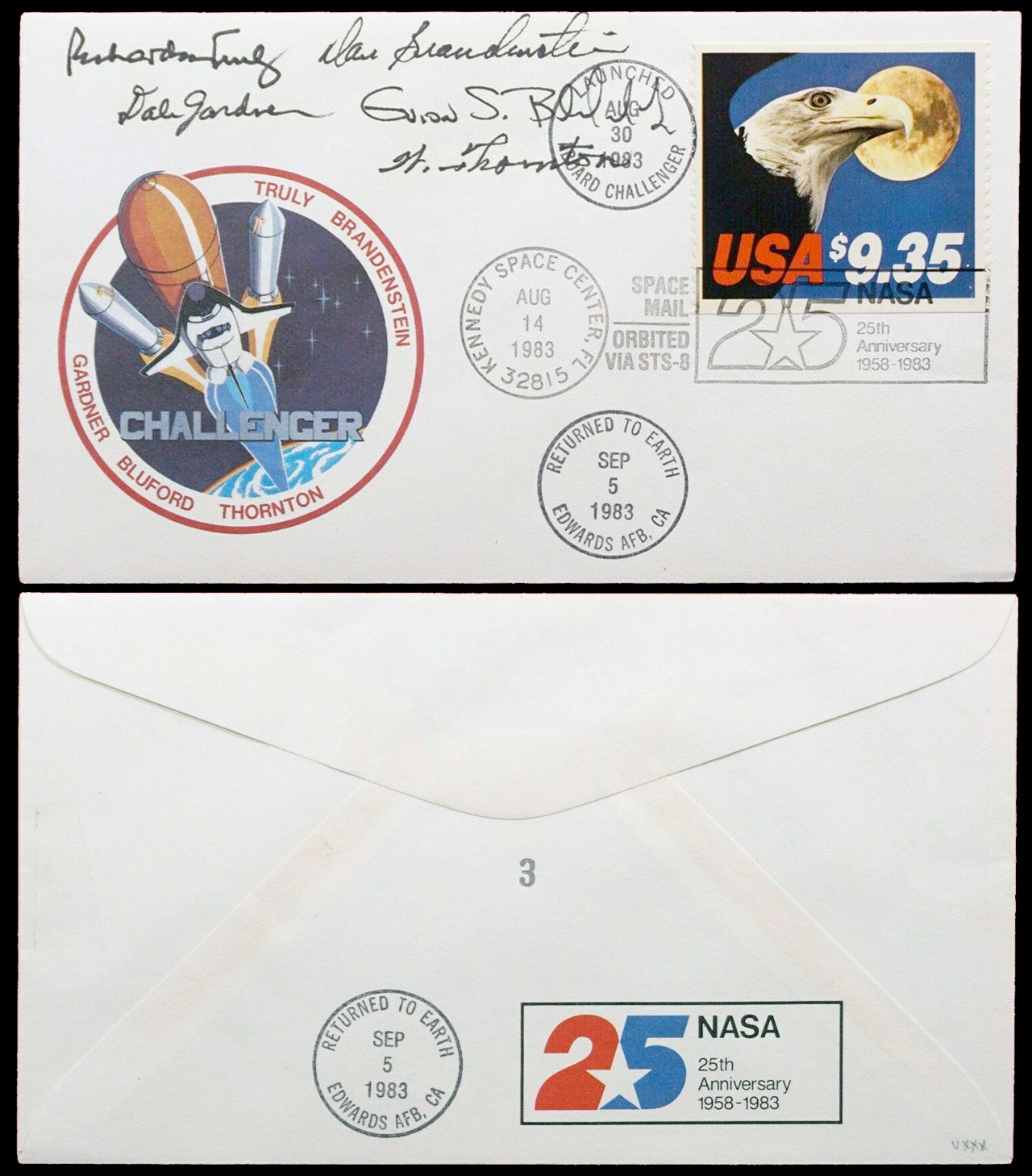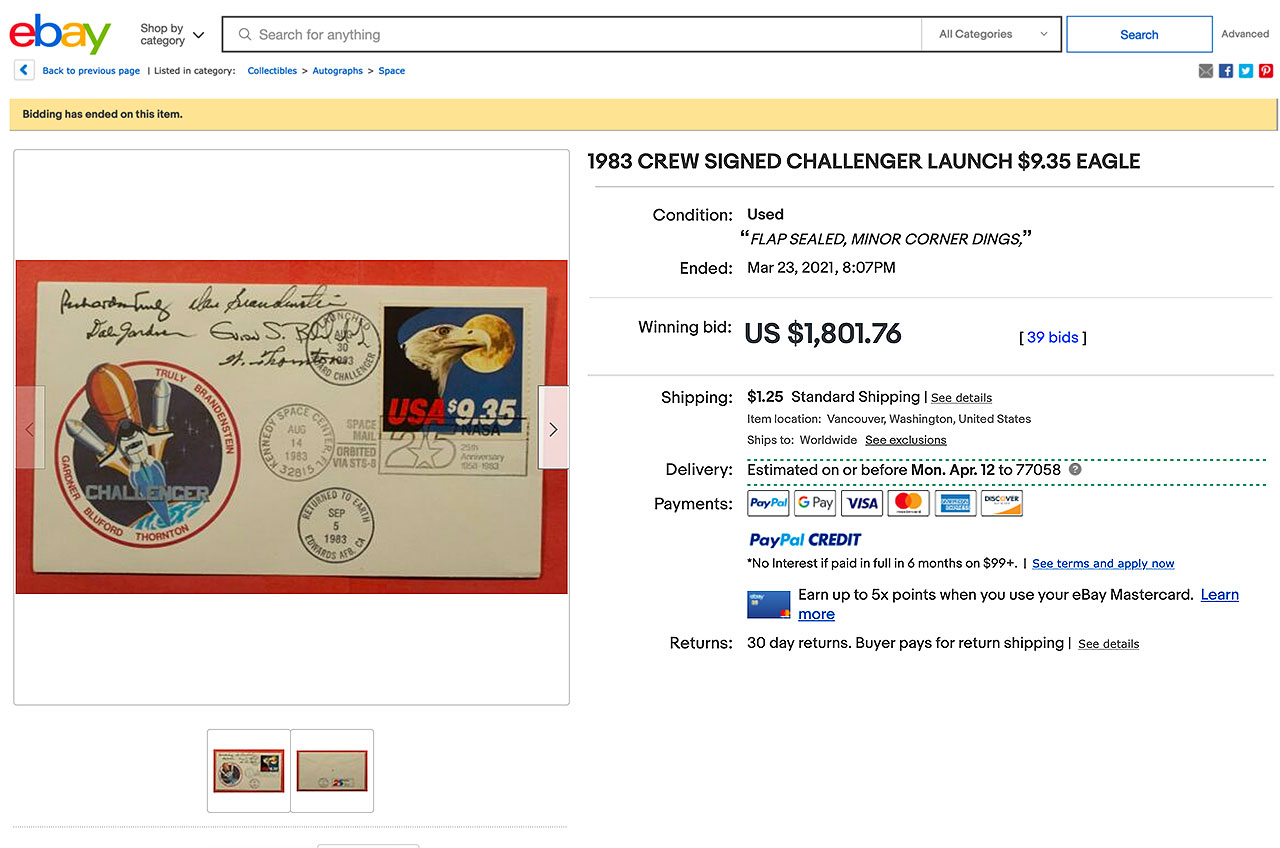Commander's cover: An envelope's flight through space, time and eBay

The last time that Richard Truly saw it, it was on board the space shuttle Challenger 38 years ago.
The small envelope, bearing a $9.35 Express Mail stamp and a special Aug. 14, 1983 postmark identifying it as "Space Mail Orbited Via STS-8," was then newly-autographed by Truly and his four STS-8 crewmates. Although there were more than 260,000 similar envelopes flying on that same mission, this one was special: serialized on its back as number "3," it was one of only 10 to be signed by all five astronauts and it was earmarked for Truly.
But Truly never received it.
"To be honest, I don't have any proof which serial number was intended for me. All I know is I never got it," said Truly, who was commander of the STS-8 mission and later served as NASA administrator. "The other four crew members got theirs, but I was the only stamp collector."
Flash forward almost 40 years and the envelope reappeared — on eBay.
9 Weird Things That Flew on NASA's Space Shuttles
Listed on March 16 for just $3 by a seller in Vancouver, Washington, the lot title identified the flown-in-space envelope only as a "1983 Crew Signed Challenger Launch $9.35 Eagle," the latter referring to the stamp, which depicted an American Bald Eagle and the moon. The lot description offered no other details, but that was okay. The photos said it all.
Get the Space.com Newsletter
Breaking space news, the latest updates on rocket launches, skywatching events and more!
Like the thousands of other envelopes flown on the STS-8 mission, the example for sale featured the crew's patch on its front and two additional postmarks: one for when Challenger launched on Aug. 30, 1983 and one for when the orbiter landed on Sept. 5, 1983. In the upper left corner were the signatures of Truly, pilot Dan Brandenstein and mission specialists Dale Gardner, Guion Bluford (the first African American astronaut to fly) and William Thornton.
On the reverse, was the number "3" and another postmark for its return to Earth.
It took only a day for collectors to begin to take notice. Bidders steadily drove up on the price until it seemed to stabilize at $132 a few hours before the auction was set to end. Then, in the final seconds, the envelope skyrocketed to $1,801.76.
David Ball had won the crew-signed STS-8 space mail.

Getaway special
NASA's press kit for the STS-8 mission details how, in celebration of the agency's 25th anniversary, the U.S. Postal Service (USPS) collaborated on the launch of the approximately 260,000 envelopes — or "philatelic covers" as collectors refer to them — aboard the space shuttle Challenger.
"Each of the covers will be placed in a specially designed folder and sold for $15.35 each, by mail order only, from the USPS Philatelic Division," NASA wrote. "Proceeds (exclusive of the postage affixed) from the sale of the Shuttle Flight Folder will be divided equally between NASA and the Postal Service."
The bulk of the envelopes were stowed in Challenger's payload bay, either in two large storage boxes that were attached to a pallet or in eight "Getaway Special" canisters, the latter more commonly used to host student and small experiments.
One thousand of the covers were set aside and packed in the shuttle's crew cabin. Flown at the request of the Postmaster General, they were intended for post-flight presentation to museums and to postal service officials. Ten of the envelopes were left accessible to the crew for them to sign during the six-day flight.
Recognizing that the public sale of the covers could result in the astronauts being overwhelmed by autograph requests, NASA directed the STS-8 crew to only sign the ten envelopes on board Challenger. (In the decades that followed the mission, four of the five crew members, including Truly, would go on to autograph additional examples on request, with only Thornton abiding by NASA's rule up until his death in January.)
After Challenger landed, the signed covers were presented to the Smithsonian, then-President Ronald Reagan and Vice President George Bush, NASA Administrator James Beggs, Postmaster General William Bolger and, as now is known, only four of the five STS-8 astronauts.

Signed, sold and delivered
Ball was already familiar with the history of the STS-8 covers when he saw the no. 3 envelope on eBay.
"One might find a few autographs on these flown covers," said Ball, a 40-year stamp collector and the author of "American Astrophilately: The First Fifty Years" (Joggling Board Press, 2010), "but seeing a crew-signed flight cover with a single digit in a six-figure series on the reverse is rather extraordinary."
Given the envelope's rarity, Ball discussed the auction with a few fellow hobbyists and became concerned that it might be stolen. One his friends mentioned having previously met Truly and was aware that the STS-8 commander was missing his signed cover. Ball decided to reach out to the astronaut to be sure.
"If this was yours and you want it back, I'm prepared to assist in whatever way I can," Ball wrote to Truly in an email. "I would love to have it, but it isn't my history and I certainly wouldn't want you cheated out of an important memento."
"I'd love to have one," Truly responded. "The last time I saw the cover was on orbit when we signed the 10 covers."
It was settled. Ball placed a sizable bid to ensure he would be the winner, with the knowledge that he was buying it on Truly's behalf.
It is not clear why Truly never received his cover when the others on the STS-8 crew did, or how it ended up on eBay 38 years later (if indeed the no. 3 cover was the one meant for Truly). Annotations on the cover's reverse suggest that at some point the cover made it into a known reference collection, says Ball, but otherwise it's a mystery.
Truly is just happy to finally be receiving a cover for his stamp collection.
"I'm watching the mail," he said.
Follow collectSPACE.com on Facebook and on Twitter at @collectSPACE. Copyright 2021 collectSPACE.com. All rights reserved.
Join our Space Forums to keep talking space on the latest missions, night sky and more! And if you have a news tip, correction or comment, let us know at: community@space.com.

Robert Pearlman is a space historian, journalist and the founder and editor of collectSPACE.com, a daily news publication and community devoted to space history with a particular focus on how and where space exploration intersects with pop culture. Pearlman is also a contributing writer for Space.com and co-author of "Space Stations: The Art, Science, and Reality of Working in Space” published by Smithsonian Books in 2018.In 2009, he was inducted into the U.S. Space Camp Hall of Fame in Huntsville, Alabama. In 2021, he was honored by the American Astronautical Society with the Ordway Award for Sustained Excellence in Spaceflight History. In 2023, the National Space Club Florida Committee recognized Pearlman with the Kolcum News and Communications Award for excellence in telling the space story along the Space Coast and throughout the world.

